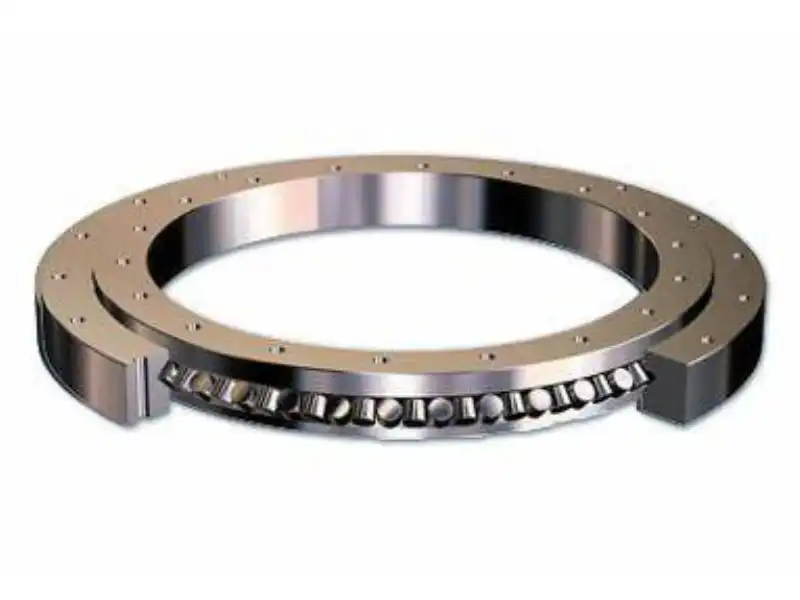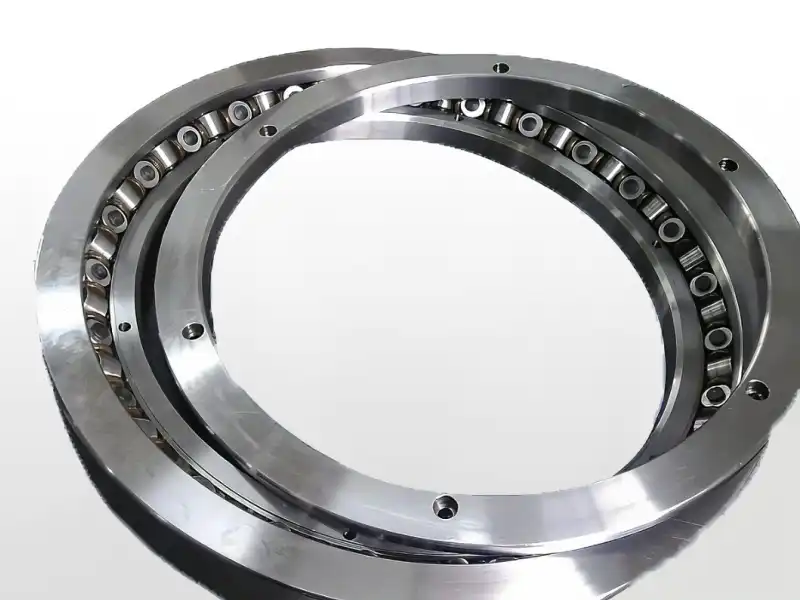Improve Your Equipment's Performance and Longevity with Cross Roller Slewing Bearings
Industrial machinery's reliability and precision heavily depend on the quality of their components, particularly bearings. Cross roller slewing bearings stand out as critical elements in various heavy-duty applications, offering superior stability and performance. This comprehensive guide explores how these specialized bearings can enhance your equipment's capabilities and operational lifespan.

Luoyang Huigong Bearing Technology Co., Ltd. brings decades of expertise to the bearing industry. With an experienced R&D team providing technical guidance, customized solutions for various operating conditions, and 30 years of industry experience collaborating with major enterprises, we deliver excellence in bearing technology. Our advanced production equipment and testing instruments, combined with over 50 invention patents and certifications including ISO9001 quality management system and ISO14001 environmental management system, demonstrate our commitment to quality. As a 2024 quality benchmark enterprise, we invite you to experience our expertise. Contact us at sale@chg-bearing.com or call +86-0379-65793878 to learn more about our products.
How Do Cross Roller Slewing Bearings Enhance Equipment Stability?
Cross roller slewing bearings feature a unique 1:1 cross arrangement of cylindrical rollers, creating an exceptional structural design that provides superior stability and precision. This configuration allows the bearings to handle both axial and radial loads effectively, making them ideal for applications requiring high precision and stability.
The bearing's structure incorporates alternating perpendicular roller arrangements, which significantly improves load distribution and reduces stress concentrations. This design feature enables the bearing to maintain optimal performance even under challenging conditions, such as sudden impact loads or variable speed operations.
Available in three main types - external gear, internal gear, and no gear - these bearings offer flexibility in design and application. The no-gear type features inner diameters ranging from 320mm to 4272mm and outer diameters from 550mm to 4726mm, with weights varying from 85.6kg to 3100kg. Both internal and external gear types share similar specifications, with inner diameters of 398-4272mm and outer diameters of 602-4726mm, weighing between 80-3100kg.

What Makes Cross Roller Slewing Bearings Essential for Heavy-Duty Applications?
The exceptional performance characteristics of cross roller slewing bearings in heavy-duty applications stem from their sophisticated material composition and advanced engineering design. These bearings are manufactured using premium-grade materials such as 50Mn, 42CrMo, S48C, 42CrMo4, and 16Mn, each selected for their specific mechanical properties that contribute to the bearing's overall performance. The 42CrMo and 42CrMo4 variants, in particular, offer enhanced hardenability and wear resistance, making them ideal for applications where consistent performance under extreme conditions is paramount. The integration of these materials with precision engineering results in bearings that can withstand substantial radial and axial loads while maintaining rotational accuracy throughout their operational lifespan.
In the realm of construction machinery, these bearings have revolutionized the way equipment operates. Take, for instance, their application in modern excavators, where the slewing bearing must support not only the dead weight of the upper structure but also dynamic loads during operation. The cross roller design's ability to handle moment loads while providing smooth rotation has made it indispensable in such applications. Similarly, in port equipment, where cargo handling machinery operates continuously under varying load conditions, these bearings demonstrate remarkable resilience. The unique cross-arrangement of rollers enables better load distribution, reducing stress concentrations and extending the bearing's operational life even under the most demanding port environments.
The defense sector particularly benefits from the high precision capabilities of cross roller slewing bearings. In high-precision radar systems, where accuracy is measured in fractions of a degree, these bearings provide the stable platform necessary for reliable target tracking. Their implementation in missile launcher systems showcases their ability to combine precision positioning with robust load-bearing capacity. The bearing's design allows for exceptional moment load capacity while maintaining the tight tolerances required for accurate targeting systems. This combination of strength and precision makes them irreplaceable in defense applications where failure is not an option.
The industrial sector has embraced cross roller slewing bearings for their versatility and reliability in automated manufacturing processes. In applications such as industrial turntables and robotic assembly systems, these bearings facilitate precise rotational movements while handling significant loads. Their design allows for minimal maintenance requirements while providing consistent performance, resulting in reduced downtime and lower operational costs. The bearing's ability to maintain accuracy under varying speeds and loads makes them particularly valuable in modern manufacturing facilities where precision and reliability directly impact production efficiency.

What Factors Should You Consider When Selecting Cross Roller Slewing Bearings?
The selection process for cross roller slewing bearings requires a comprehensive understanding of both the application requirements and the bearing's technical capabilities. Load analysis stands as the primary consideration, encompassing not just the static and dynamic load capacities but also the complex interplay of forces that occur during operation. Engineers must evaluate the combined effects of radial, axial, and moment loads, considering both steady-state conditions and transient loads that may occur during start-up, shutdown, or emergency situations. The bearing's capacity to handle peak loads without compromising its structural integrity or precision is crucial for ensuring long-term reliability and safety.
Environmental considerations play a pivotal role in bearing selection and significantly impact long-term performance. Operating temperature ranges must be carefully evaluated as they affect lubricant behavior and material properties. In applications where bearings are exposed to harsh conditions, such as marine environments or dusty industrial settings, special attention must be paid to sealing solutions and protection against contaminant ingress. The selection of appropriate sealing systems and lubricants becomes critical in ensuring the bearing's longevity and maintaining its performance characteristics. Modern cross roller slewing bearings often incorporate advanced sealing technologies and surface treatments that enhance their resistance to environmental factors while reducing maintenance requirements.
The operational parameters of the application demand careful consideration during the selection process. Rotation accuracy requirements must be matched with the bearing's inherent precision capabilities, taking into account factors such as manufacturing tolerances and installation procedures. Operating speed profiles need to be analyzed to ensure the bearing can maintain its performance characteristics throughout the speed range while managing heat generation and lubrication requirements effectively. The selection of gear type - external, internal, or no gear - must align with the drive system specifications and space constraints of the application. External gear types offer advantages in terms of accessibility and maintenance, while internal gear configurations provide better protection against environmental contamination and often allow for more compact designs.
Maintenance considerations and lifecycle costs form an integral part of the selection criteria. While cross roller slewing bearings are designed for extended service life, their performance longevity depends significantly on proper installation, regular maintenance, and appropriate operating conditions. Factors such as accessibility for inspection and lubrication, monitoring capabilities, and maintenance intervals must be evaluated during the selection process. Advanced bearing designs now incorporate features that facilitate condition monitoring and predictive maintenance, allowing operators to optimize maintenance schedules and prevent unexpected failures. The initial investment in a higher-quality bearing often results in lower total ownership costs through reduced maintenance requirements and extended service life.
With many successful collaborations domestically and internationally, we invite you to learn more about our products by contacting CHG at sale@chg-bearing.com or calling our hotline at +86-0379-65793878.
References:
1. Journal of Mechanical Design, "Advanced Bearing Technology in Industrial Applications" (2023)
2. International Journal of Mechanical Engineering, "Analysis of Cross Roller Bearing Performance in Heavy Equipment" (2023)
3. Manufacturing Technology Quarterly, "Materials Selection in Industrial Bearing Applications" (2024)
4. Industrial Machinery Standards Institute, "Guidelines for Slewing Bearing Selection and Maintenance" (2023)
5. Engineering Design Handbook, "Rotary System Components and Their Applications" (2024)

